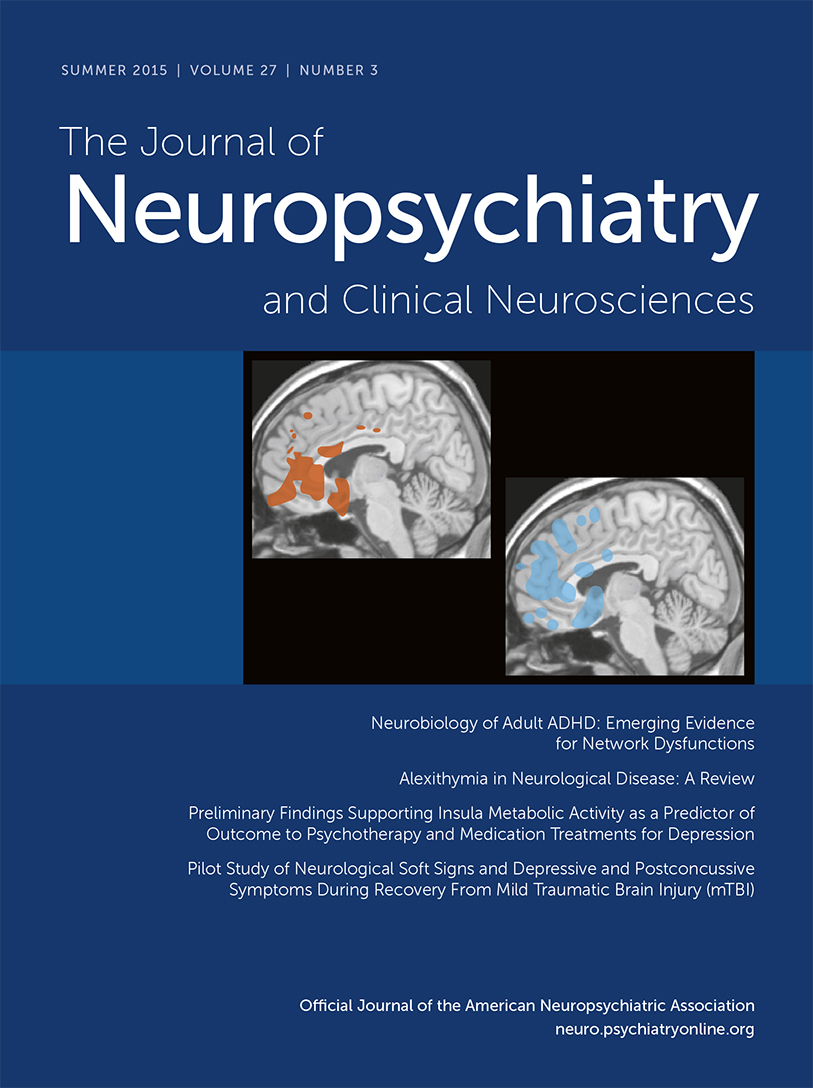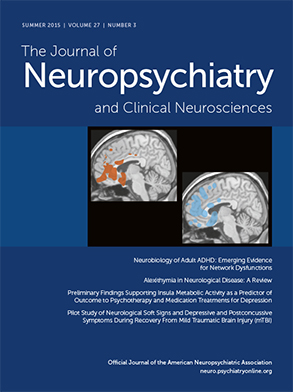To the Editor: Psychiatric comorbidity in Huntington Disease (HD) includes executive dysfunction, affective dysregulation, obsessive-compulsive disorder (OCD), and psychosis.
1 Premorbid psychopathology in HD is rarely discussed. We describe a case of HD and preceding trichotillomania (TTM), a disorder of repetitive and excessive hair pulling leading to significant psychological distress.
2 Few patients with TTM have a neurodegenerative process compounding their problems with impulse control, compulsions, and perseverative behaviors. We suggest that executive dysfunction secondary to HD exacerbated TTM in this patient, whose hair pulling and motor symptoms improved dramatically with the partial dopamine agonist aripiprazole.
Case Report
After her father’s diagnosis of HD, a 39-year-old woman self-referred for predictive testing. Her genetic testing revealed a CAG repeat expansion of 41 in the HTT gene. Her past medical history included asthma, depression, generalized anxiety disorder, and TTM. There was no family history of OCD or anxiety disorder. However, her father had longstanding hoarding behavior and a compulsive shopping disorder (oniomania) prior to HD diagnosis, and paranoia and social isolation as the disease developed. One of her three daughters has binge eating tendencies and excessive eyebrow plucking (her psychiatric diagnoses and HD genetic status are unknown). The patient’s TTM began at age 6 and worsened with heightening of mood and anxiety symptoms and psychosocial stressors. She experienced nonsustained benefit from clomipramine, sertraline, fluoxetine, fluvoxamine, venlafaxine, citalopram, and paroxetine.
At presentation, she lacked motor signs of HD, and disaffirmed depression, OCD, and additional impulse control disorders. Her TTM was somewhat controlled with pimozide, at an hour daily of hair pulling. Nonetheless, she had bald patches on her scalp and eyebrows, no eyelashes, and wore a wig. Pimozide later caused unwanted blepharospasm and orobuccolingual dyskinesias, and was discontinued.
Eight years after presentation, the patient manifested motor signs of early HD, mild executive dysfunction, and declining functional status. She was forced to stop working at this time. She demonstrated mild deficits on the Montreal Cognitive Assessment in domains typically affected in HD including sustained attention, verbal retrieval, executive function, and abstraction. Olanzapine was started for TTM and chorea but was discontinued because of rapid and significant weight gain. Subtle speech and swallowing difficulties, jerky saccades, gait instability, and other motor sequelae of HD progressed. She started spending 10 hours per day plucking hairs. By 12 years after first presentation, she started 2 mg aripiprazole and titrated up to 5 mg.
Benefits from treatment were evident within 6 weeks of initiation and, when examined 18 months after starting aripiprazole, the TTM had fully remitted. She continued to manifest jerky saccades and mild gait instability, but neurologically, she had significantly improved. The mild executive dysfunction, cognitive deficits, and family- and work-related stressors remained unchanged. She gradually gained 30 kg (66 lbs), resulting in mild obstructive sleep apnea and glucose intolerance. She was too pleased with her progress to consider pharmacological changes.
Discussion
This report is the first to demonstrate improvement in TTM and HD with aripiprazole. TTM is historically classified as an OCD spectrum condition, for which dopamine modulating medications serve only as augmentation agents.
3 Some reports demonstrate remission of TTM (in the absence of neurological disease) with aripiprazole after failed management with serotonergic agents.
2,4 Successful management of motor and behavioral symptoms of HD with aripiprazole has been documented.
5 Our patient’s lack of response to serotonergic agents suggests that either her TTM worsening was not secondary to an exacerbation in anxiety or depression, or the severity of her condition necessitated augmentation with dopamine modulators.
The patient’s early age of onset of TTM compared with age of onset of HD, and her family history of impulse control disorders and behaviors suggest distinct pathophysiologies of TTM and HD. However, although her TTM was correlated with her anxiety and depression, it was most severe after the onset of HD-related decline in executive functioning. Patients with TTM, and to a lesser degree their unaffected first-degree relatives, show impaired motor inhibition compared with healthy individuals on the Stop-Signal Task.
6,7 Further impairment of inhibitory control through HD-related executive dysfunction likely contributed to the exacerbation of this patient’s TTM symptoms manifesting as 10 hours of pulling per day.
There is no evidence in the literature supporting a distinct pathological connection between TTM and HD. A cohort from the Predict-HD study
8 was asked to rate global psychological distress and the total number and intensity of self-reported psychiatric symptoms (including depression, anxiety, hostility, and obsessive-compulsive behaviors, among others) on the Symptom Checklist 90-R. Individuals with the HD gene expansion, despite estimations that most were more than 10 years from diagnosis, manifested subtle elevations in scores compared with expansion-negative controls, who were predominantly blood relatives. Trichotillomania is not mentioned as a premorbid psychiatric condition in HD. Should our patient’s only daughter of three to manifest an impulse control disorder later develop HD, this would be the first three-generation family history of premorbid impulse control disorders and HD reported. Three-generation-long family histories of HD and premorbid schizophreniform psychosis have been described.
9,10A recent review of the genetics of TTM suggests no discernible overlap with HD. Heritability estimates of TTM are, however, high at 0.76 to 0.78, and several genes have been associated with the disease, including:
5HT2a,
Sapap3, and
SLITRK1.
11 In a candidate gene study, the
5HT2a T102C polymorphism was significantly more abundant in TTM patients compared with healthy controls.
12 This has potential implications for understanding the effectiveness of aripiprazole in TTM, with its antagonism of 5HT2a receptors in addition to its partial D2 and 5HT1a agonistic activity. In our case, antagonism of dopamine and 5HT2a receptors by aripiprazole may explain the mechanism of improvement of our patient in terms of motor symptoms and impulse control.
This case illustrates the potential significant benefit of appropriate exploration of pharmacotherapies for HD patients with psychiatric comorbidities. We suggest that management of worsening comorbid psychiatric conditions, particularly impulse control disorders, in patients with HD should involve assertive pharmacological management, with early consideration for the use of dopamine modulators.

